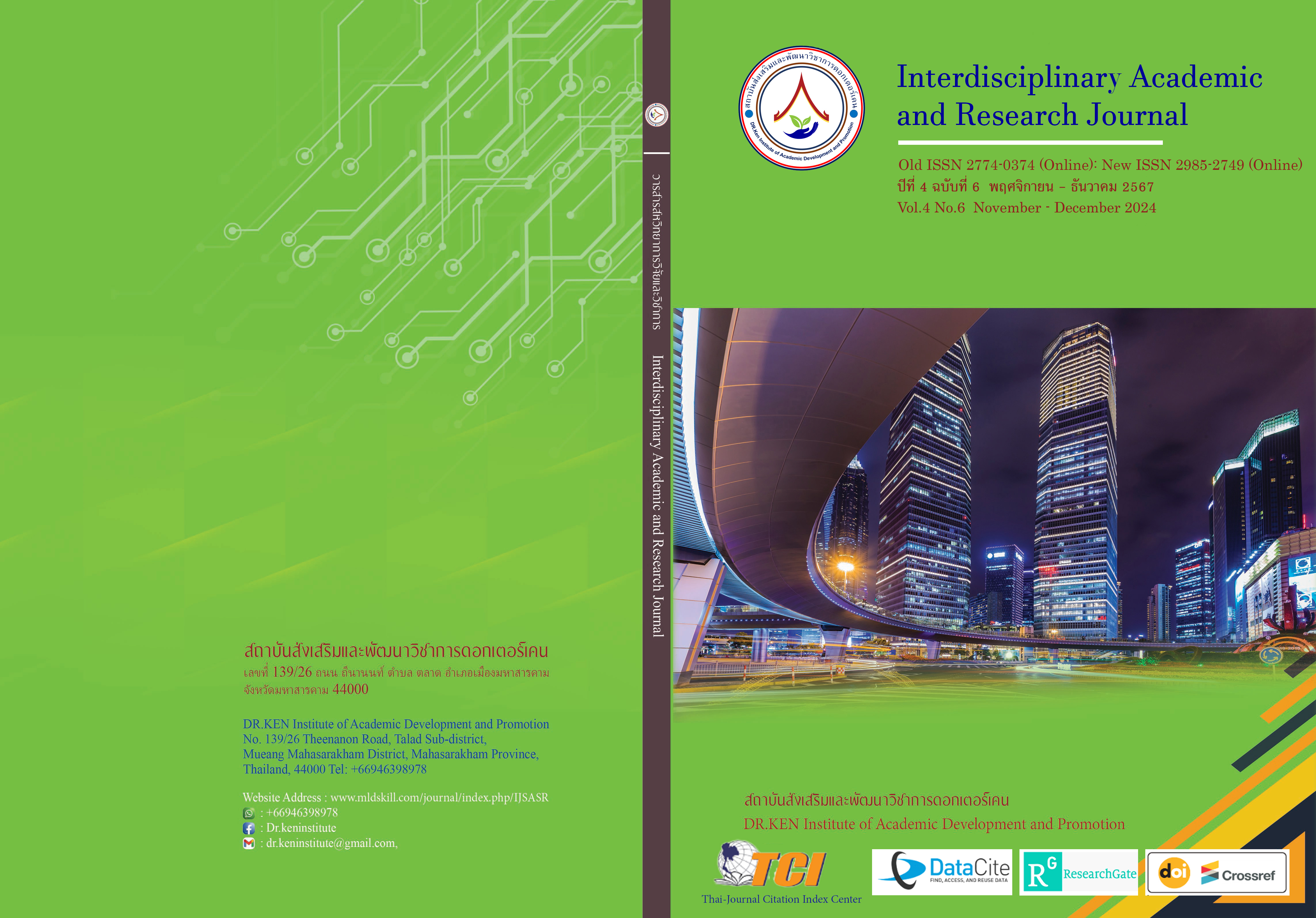Game-Based Learning (GBL) Management to Acquire Academic Achievement and Creative Thinking on Land and Water of Grade 8 Students
DOI:
https://doi.org/10.60027/iarj.2024.278475Keywords:
Game-Based Learning, Learning Achievement, Creative Thinking Learning AchievementAbstract
Background and Aims: Game-Based Learning It is a teaching method that uses games as a tool for organizing activities to enable students to learn according to the specified objectives. Stimulate interest in the lesson and make students excited, challenged, and fun. Create motivation for students to want to learn on their own and make students more involved in learning activities. This research aimed to achieve two objectives 1) to compare academic achievement on Land and Water with the criteria of 70 percent and 2) to study creative thinking of grade 8 students after the game-based learning on Land and Water.
Methodology: The sample group was a classroom of forty-three grade 8 students in the academic year 2023 from cluster random sampling. Research instruments composed of 1) the four multiple choices, 25 items of learning achievement test on Land and Water for grade 8 students Items have a precision value between 0.67-1.00, a difficulty value between 0.23-0.70, a discriminatory power value between 0.18-0.66, and a confidence value for the entire document at 0.91 and 2) the activity creativity test for grade 8 students consisted of 4 activities with 4 aspects; Originality, Fluency, Flexibility and Elaboration It is appropriate at a very appropriate level. The discriminatory value is between 0.43-0.50 the difficulty value is between 0.40-0.53 confidence value for the entire model is (Cronbach alpha) equal to 0.99. Data analysis statistics were mean, standard deviation, and one sample t-test.
Results: The research found that; the students had an academic achievement of 75 percent after Game-based Learning statistically higher than the 70 percent criteria at the .05 significant level. The students had creative thinking after the Game-Based Learning overall at a high level. They responded with their Originality Thinking, Flexibility Thinking, Fluency Thinking, and Elaboration Thinking, at high levels, respectively.
Conclusion: 1) The students had academic achievement after the Game-based Learning statistically higher than the 70 percent criteria at the .05 significant level and 2) the students had creative thinking after the Game-Based Learning in every aspect at the high level.
References
กฤติกา ครูฑกาศ. (2558). ความคิดสร้างสรรค์ก่อให้เกิดความสนุก. Retrieved from: https://cms.dru.ac.th/jspui/bitstream/123456789/14/25/appendix.pdf
ชณัญญา สุทธิพิทยศักดิ์. (2563). การสังเคราะห์งานวิจัยที่เกี่ยวข้องกับการใช้รูปแบบเกมการศึกษาเพื่อจัดการเรียนการสอนในรายวิชาภาษาไทย. วารสารวิชาการมหาวิทยาลัยราชภัฏศรีสะเกษ, 14(1), 22-33.
ชัญญาภัค หล้าแหล่ง. (2561). การสร้างเครือข่ายทางธุรกิจกับความได้เปรียบทางการแข่งขันของกลุ่มวิสาหกิจชุมชนในพื้นที่จังหวัดชุมพร. Veridian E-Journal, Slipakorn University ฉบับภาษาไทย สาขามนุษยศาสตร์ สังคมศาสตร์ และศิลปะ., 11(2), 3447-3461.
ถนอมพร เลาหจรัสแสง และ อุไรวรรณ หาญวงค์ (2552). การบูรณาการเทคโนโลยี e-Learning ประเภทเกมในชั้นเรียน. การประชุมทางวิชาการของมหาวิทยาลัยเกษตรศาสตร์ ครั้งที่ 45: สาขาศึกษาศาสตร์ สาขาเศรษฐศาสตร์และบริหารธุรกิจ สาขามนุษยศาสตร์และสังคมศาสตร์
นิพาดา เทวกุล. (2554). ความสำคัญของความคิดสร้างสรรค์. Retrieved December 9, 2021, from: https://fulltext.rmu.ac.th/fulltext/2558/115202/chapter2.pdf
พวงรัตน์ ทวีรัตน์. (2545). วิธีการวิจัยทางพฤติกรรมศาสตร์และสังคมศาสตร์. พิมพ์ครั้งที่ 7. กรุงเทพฯ: สำนักพิมพ์ จุฬาลงกรณ์มหาวิทยาลัย.
พันธ์ ทองชุมนุม. (2547). การสอนวิทยาศาสตร์ระดับประถมศึกษา. กรุงเทพฯ: โอเดียนสโตร์.
พิชญานิน วาสะศิริ และอัมพร วัจนะ. (2563). การเปรียบเทียบผลสัมฤทธิ์ทางการเรียน วิชาวิทยาศาสตร์เรื่องพลังงานความร้อนและลมฟ้าอากาศ ของนักเรียนชั้นมัธยมศึกษาปีที่ 1โรงเรียนพรตพิทยพยัต ที่ใช้เกมเป็นสื่อประกอบการสอนกับการสอนแบบปกต. งานประชุมวิชาการระดับชาติ ด้านวิทยาศาสตร์และเทคโนโลยีเครือข่ายภาคใต้, 6, 598-606.
โรงเรียนร้อยเอ็ดวิทยาลัย. (2566). แผนปฏิบัติการประจำปีการศึกษา 2566 โรงเรียนร้อยเอ็ดวิทยาลัย. Retrieved from: https://www.rw.ac.th/rw/attach_weblink/attach_143.pdf
ลักขณา สิริวัฒน์. (2558). การรู้คิด. กรุงเทพฯ: โอเดียนสโตร์.
วรรณรัตน์ อึ้งสุประเสริฐ. (2554). การวิจัยทางการศึกษา. กรุงเทพฯ: คณะศึกษาศาสตร์ สถาบันราชภัฏจันทร์เกษม.
สถาบันส่งเสริมการสอนวิทยาศาสตร์และเทคโนโลยี. (2560). การจัดสาระการเรียนรู้กลุ่มคณิตศาสตร์ (ฉบับปรับปรุง 2560) ตามหลักสูตรการศึกษาขั้นพื้นฐาน พุทธศักราช 2551. กรุงเทพมหานคร: สถาบันส่งเสริมการสอนวิทยาศาสตร์และเทคโนโลยี.
สมาน อัศวภูมิ. (2558). เอกสารคำสอนรายวิชาการบริหารสำหรับครู (ฉบับปรับปรุง). (พิมพ์ครั้งที่ 2). อุบลราชธานี: มหาวิทยาลัยราชภัฏอุบลราชธานี.
สำนักงานปลัดกระทรวงศึกษาธิการ. (2565). ยุทธศาสตร์การวิจัยของสำนักงานปลัดกระทรวงศึกษาธิการ 2565-2569. Retrieved from: https://ops.moe.go.th/ยุทธศาตร์การวิจัยของสำ/
สำนักงานเลขาธิการสภาการศึกษา. (2565). สรุปสาระสำคัญรายงานผลการติดตามและประเมินผลการดำเนินงานตามแผนการศึกษาแห่งชาติ พ.ศ.2560-2579 ในระยะ 5 ปีแรกของแผน (พ.ศ.2560-2564). สรุปสาระสำคัญรายงานผลการติดตามและประเมินผลการดำเนินงานตามแผนการศึกษาแห่งชาติ พ.ศ.2560-2579 ในระยะ 5 ปีแรกของแผน (พ.ศ.2560-2564)
สำนักทดสอบทางการศึกษาแห่งชาติ. (2565). รายงานและบทความวิชาการ. Retrieved from: https://www.niets.or.th/th/catalog/view/497
สุคนธ์ สิธพานนท์ (2551). การจัดกระบวนการเรียนรู้ที่เน้นผู้เรียนเป็นสำคัญ. กรุงเทพฯ: อักษรเจริญทัศน์.
สุวิทย์ มูลคำ และอรทัย มูลคำ. (2545). 21 วิธีจัดการเรียนรู้เพื่อพัฒนากระบวนการคิด. กรุงเทพฯ: ภาพพิมพ์.
อัจฉราพรรณ โพธิ์ตุ่น, และสุธาทิพย์ งามนิล. (2558). ผลการสอนโดยใช้เกมตามแนวการเรียนรู้โดยใช้สมองเป็นฐานที่มีต่อผลสัมฤทธิ์ทางการเรียนและเจตคติต่อการเรียนวิชาภาษาอังกฤษของนักเรียนชั้นประถมศึกษาปีที่ 2. วิทยานิพนธ์หลักสูตรครุศาสตรมหาบัณฑิต: มหาวิทยาลัยราชภัฏนครสวรรค์.
Bloom, J.D., & Cutler, D.L. (1982). The CMHC is a setting for residency education. Community Mental Health Journal, 18(1), 3-10.
Guilford, J.P. (1967). Creativity: Yesterday, today, and tomorrow. The Journal of Creative Behavior, 1(1), 3-14.
Guilford, J.P., & Smith, P.C. (1959). A system of color preferences. The American Journal of Psychology, 72(4), 487-502.
Taylor, C.W., & Holland, J. (1964). Predictors of creative performance. In C. W. Taylor (Ed.), Creativity: Progress and potential (pp. 15–48 ).
Downloads
Published
How to Cite
Issue
Section
License
Copyright (c) 2024 Interdisciplinary Academic and Research Journal

This work is licensed under a Creative Commons Attribution-NonCommercial-NoDerivatives 4.0 International License.
Copyright on any article in the Interdisciplinary Academic and Research Journal is retained by the author(s) under the under the Creative Commons Attribution-NonCommercial-NoDerivatives 4.0 International License. Permission to use text, content, images, etc. of publication. Any user to read, download, copy, distribute, print, search, or link to the full texts of articles, crawl them for indexing, pass them as data to software, or use them for any other lawful purpose. But do not use it for commercial use or with the intent to benefit any business.
















.png)


